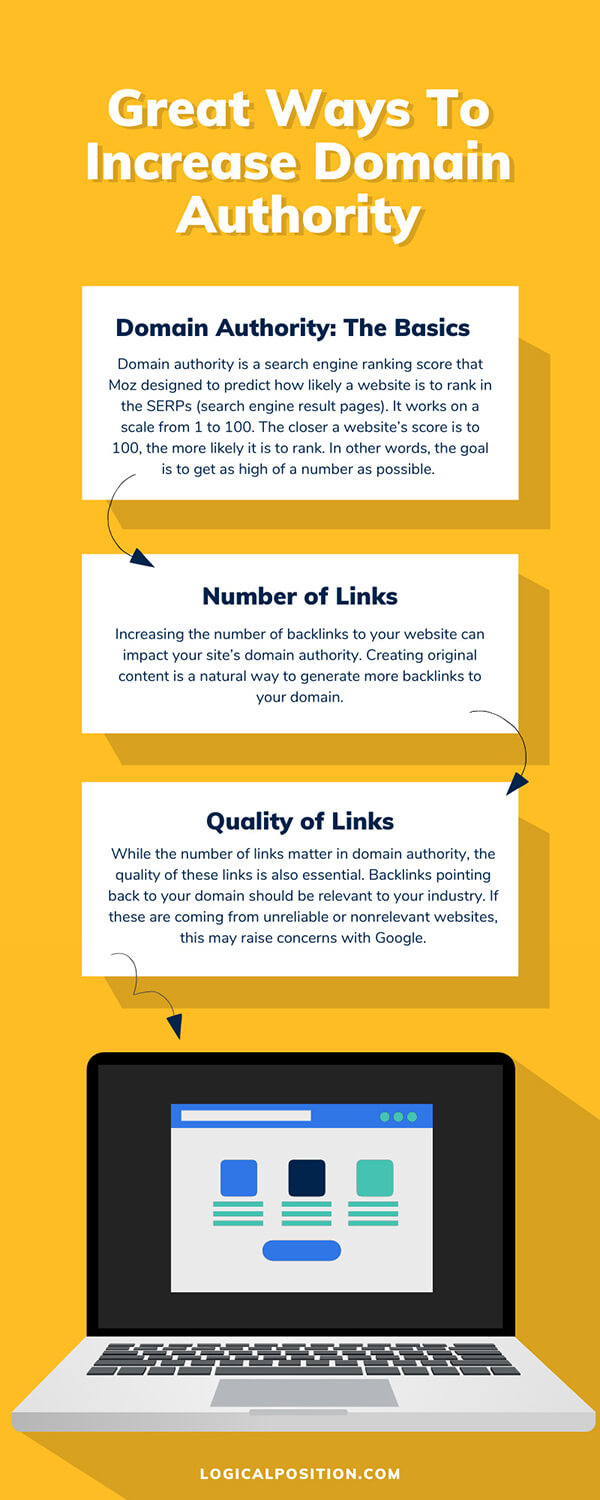In the past few decades, it has become essential for businesses to have an online presence. The digital landscape is continuously changing, which means companies must keep up. Every business needs a credible, authoritative website to ensure they’re visible to their customers. One way to get a holistic view of how your website compares to your competition is to look at your domain authority. If it’s low, you’ll want to check out these great ways to increase domain authority.
Domain Authority: The Basics
What It Is
Domain authority is a search engine ranking score that Moz designed to predict how likely a website is to rank in the SERPs (search engine result pages). It works on a scale from 1 to 100. The closer a website’s score is to 100, the more likely it is to rank. In other words, the goal is to get as high of a number as possible.
Why It Matters
Knowing your website’s domain authority is beneficial because it’s a trackable metric associated with how well the site ranks on search engines such as Google. While page authority is vital to monitor and allows for trackable growth at a more granular level, domain authority provides a holistic view of your website’s overall impact.
Things To Note
Google does not use domain authority to determine search rankings, but it can be a valuable metric to note. However, it should not be the only one your business looks at when analyzing your website’s SEO performance.
Number of Links
Increasing the number of backlinks to your website can impact your site’s domain authority. Below, you’ll find a few ways to get more backlinks to your website while abiding by Google’s best practices.
Create Shareable Content
Creating unique, shareable content is the most reliable way to increase your website’s domain authority. Putting up original content that is easily shareable is a natural way to get links back to your domain. This is the preferred method for Google because it wants all websites to have shareable, digestible content that is accessible to everyone.
Make User-Friendly Content
Ensure that any content on your website is user-focused. The goal is to create content that is digestible and easy to read. Aim to build attention-grabbing, accurate, unique, and beneficial content while staying on-topic.
Link Outreach
Link outreach is a method of generating more backlinks to your site. There are a couple of ways to go about this.
The first method is guest posting. In this method, you will create a piece of high-quality content that is relevant to your industry. The next step would be to reach out to people in your industry to see if they would be willing to post your piece of content on their site.
Another method is creating quality content for your own site. You would then reach out to relevant websites in your industry to see if they would be willing to share or link back to your content. You can even see if they’d agree to link back to a product or category on your site.
Here are a few tips for manual link outreach.
- Reach out to many people – Link outreach is much like sales; it’s all a numbers game.
- Make your initial contact stand out – Website owners get these pitches every day; ensure your pitch sets you apart.
- Ensure the websites you approach relate to your content – Keep your search to sites relevant to your website.
Keep in mind that you don’t want to keep shopping the same content piece, as this can result in duplicate content.
Sift Through Results
Browse the Internet for places where websites mention your company or products but do not link back to your site. Asking sites, such as review websites and industry-based publications, to add a link where they mention your brand can help add reliable and relevant backlinks to your site’s repertoire.
Look at Your Competitors
Take a look at where your competitors are getting their backlinks from. If a website is willing to link back to your competitors, they’re likely to do the same for you. Reach out to these online references and ask that they include a link to your site. This is a more targeted approach to link outreach.
Fix Broken Backlinks
Use a tool, such as those from Moz and Ahrefs, to identify broken backlinks to your website. Once you find the broken page, you can either put that page back up on your site or create a similar one. If you end up creating a similar page, you will need to reach out to the referring site’s owner and see if they can replace the old link with the new one. It is also a great way to reinvigorate a potentially lost relationship with a digital publication.
If connecting with the referring site’s owner is not an option, creating a redirect from the old link to the new link will help salvage some link equity.
Quality of Links
While the number of links matters in domain authority, the quality of these links is also essential. The backlinks you seek out should hold relevance to your industry. If those backlinks are coming from an unreliable or sketchy website, it raises concerns with Google.
After the Penguin update from Google, link relevancy and quality became extremely important. Before this update, many websites were gaming the system by creating non-credible sites to generate tons of links without quality or user-focused content. Now, Google looks for the number of links and the quality of those links.
If a website has a notable number of undesirable backlinks, Google could ignore them or even manually penalize that company and remove the website from Google altogether. Here are some tips for ensuring your backlinks are high-quality and beneficial.
Use Different Linking Tools
Use different linking tools to build an inventory of the links back to your site across the web. Moz, Ahrefs, and Google Search Console all have tools to identify where you’re getting most of your backlinks from.
Take inventory and see if there are any issues. If there are issues, consider the following methods of reconciliation.
Create a Disfollow List
If you find backlinks from less-than-ideal sources, one way to rectify the situation is to create a disfollow list. This list should include domains that you do not want to be associated with your website. After compiling the list, you should submit it to Google. This is an excellent method to handle non-relevant, spammy, or malicious backlinks.
Tag Sponsored Links
Google frowns upon paid backlinks, as it is working to build the most user-friendly internet experience through authenticity. If you do pay for backlinks, it’s best to mark them as such in the spirit of transparency. Additionally, keep sponsored posts very unique and user-focused so that Google does not penalize your website.

How Logical Position Can Help
Here at Logical Position, we abide by Google’s best practices of creating relevant content and linkable assets. We boast a robust network of publishers that allows us to get natural backlinks for our clients without violating Google’s guidelines. We provide quicker results than companies can achieve through manual link outreach efforts.
Contact Logical Position today for a free consultation on our search engine optimization services.




